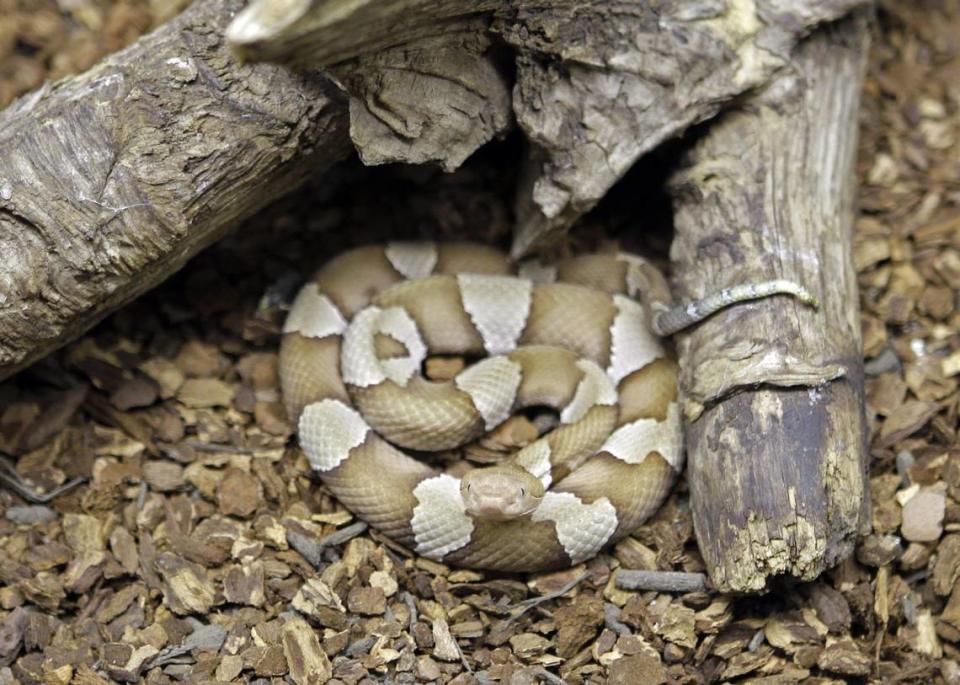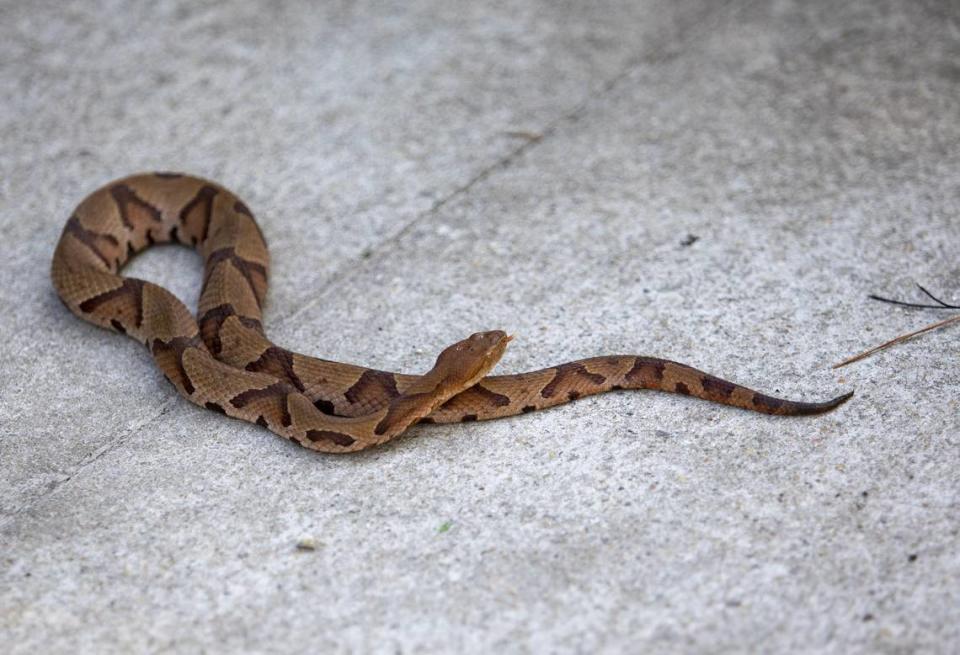How do you treat a copperhead snake bite? UNC and Duke doctors walk us through it.
Copperhead snakes, the most common venomous snake in North Carolina, are not aggressive snakes, but they can be territorial and may bite if they feel threatened.
The bite from the brownish-gray snake with the Hershey’s Kiss-shaped pattern is rarely deadly, but can be painful and expensive to treat.
What does proper treatment for a copperhead (or other) snakebite look like?
The News & Observer spoke with Dr. Charles Gerardo (an emergency medical specialist with Duke Health) and Dr. Eugenia Quackenbush (an emergency physician with UNC Medical Center) for answers.
Responses have been edited for length and clarity.
How are copperhead bites treated? Is antivenom needed?
Dr. Quackenbush:
“Copperhead bites can cause serious local reaction, which can result in pain and debility in the affected limb. There is a range of severity, from dry bite, mild, moderate to severe. Antivenom treatment can speed recovery and reduce need for opiate pain medications.
“The decision on whether to use antivenom is complex and depends on the severity of the bite, which is assessed by initial presentation, systemic symptoms and progression of swelling over time. Treatment usually consists of an initial dose of four to six vials, and then additional vials may be needed if the swelling spreads or systemic signs worsen. Your doctor may mark the edge of the swelling with a skin marker and re-assess periodically to observe for progression.
“Antivenom is not always required to treat a copperhead bite, but it is important to be evaluated by a physician with expertise in treating venomous snakebites in order to make that determination.”
Dr. Gerardo:
“Copperhead snakebite patients should be treated with a similar approach to other venomous snakebites. All venomous snakebites should all be evaluated. Patients should be offered antivenom when indicated. ... Currently for all US pit vipers, including copperhead snakebites, indications for antivenom include symptomatic mild, moderate and severe bites. It is indicated for even mild bites as the potential benefits outweigh the minimal risk of antivenom treatment.
“Although most mild copperhead bites will eventually recover, even without treatment, we also know that most patients with mild bites on presentation will progress to moderate or severe bites, and that early treatment is associated with better patient outcomes.
“The only reason to not treat most patients would be, if after a detailed discussion with the patient (or family member), they do not want to proceed due to concerns regarding cost to them. That being said, despite the large numbers on the bill, the actual cost to the patients often is in the modest range of numbers.”

How much does snake antivenom cost?
▪ At UNC Health: For a typical initial dose of four to six vials, the total charge for the antivenom can range from $76,000 to $115,000, per UNC Health’s pharmacy team.
Most insurance plans cover anti-venom treatment, and uninsured patients both receive a discount and may apply for financial aid.
▪ At Duke Health: The N&O reported in 2020 that 12 vials of antivenom — double the typical initial dose, per UNC Health — cost $200,000. When asked for this report, Duke Health declined to provide costs as of 2022 for antivenom treatment.
However, with the introduction of a second option for antivenom, the price charged to hospitals has “gone down substantially, and this results in significantly lower bills to patients and insurers,” Duke Health officials said.
Is antivenom always required to treat snakebites?
Dr. Gerardo:
“No. Antivenom is not indicated for dry bites.
“Dry bites are snakebites from a venomous snake that never develop symptoms because no venom is injected into the patient. However, patients with dry bites should be observed for eight years per current recommendations, as some snakebites initially appear to be dry bites, but later progress to symptomatic bites and require treatment.
“Another reason to not treat is if there is a medical contraindication to treatment. Lastly, we would not treat if the patient does not want treatment in hopes that they would fully recover without it, despite a more prolonged course of recovery.”
Do patients need to be hospitalized after a copperhead snakebite?
Dr. Gerardo:
“The typical course from bite to discharge is about 36 hours, with the average copperhead snakebite patient having symptoms peak at 24 hours.”
Do you always need medical attention for snakebites?
Dr. Gerardo:
“All symptomatic venomous snakebites should seek evaluation, as the majority will meet indications to benefit from treatment. ... For venomous non-copperhead snakebites in NC, these patients should also seek care, as they are worse on average.
“Additionally, snake species identification is notoriously inaccurate. Juvenile cottonmouth snakes are often misidentified as copperheads.”

Can you use home remedies or treatments for snakebites?
Dr. Gerardo:
“No. Most home remedies are not beneficial, and many are harmful, including tourniquets, venous tourniquets, cutting, suction devises, and even ice.
“For non-venomous snakebite, cleaning the wound, updating tetanus vaccination as needed and standard wound care is usually enough.”
What else should we know about treating copperhead bites?
Dr. Gerardo:
“Immediately seek care at an emergency department with experience in managing snakebites.
“Fortunately, there are now two competing antivenoms available — CroFab and Anavip — and the cost to most facilities has dropped by more than 50%. Additionally, more than three out of four patients with snakebite in NC have some sort of health coverage. For those that do not, our facility’s experts will work with the patient to manage cost to the patient. In most cases, the actual cost to most patients is modest, which allows them to focus on receiving a beneficial and safe treatment to maximize their recovery.”

Symptoms and signs of a snakebite
If you think you’ve been bitten by a snake, but you’re not quite sure — maybe because you didn’t see the snake, or for another reason — there are several signs and symptoms that could indicate a bite, according to the CDC:
Puncture marks at the wound
Redness, swelling, bruising, bleeding or blistering around the bite
Severe pain and tenderness at the site of the bite
Nausea, vomiting or diarrhea
Labored breathing (in extreme cases, breathing may stop altogether)
Rapid heart rate, weak pulse, low blood pressure
Disturbed vision
Metallic, mint, or rubber taste in the mouth
Increased salivation and sweating
Numbness or tingling around face and/or limbs
Muscle twitching
If you are experiencing these symptoms after a possible snake bite, it’s important to act as soon as possible and seek medical attention.
What to do if you’ve been bitten by a snake
UNC Health provides the following steps to follow after a possible snake bite:
▪ Stay calm and move away from the snake so it can’t bite you again.
▪ Seek medical attention at an emergency department right away. If the bite is severe enough, you may need antivenom treatment, and the quicker the it can be started, the sooner irreversible damage from the bite can be stopped, the CDC says. Note: It is recommended to have someone else drive you to the hospital, whether that’s someone driving you in a car or being picked up by an ambulance. Snakebites can cause you to become dizzy or pass out, which makes driving yourself unsafe.
▪ Sit still and stay calm until you are able to get help. “Venom seems to travel more with increased heart rate, which can lead to more complications,” UNC Health says.
▪ Remove any tight jewelry or clothing from the bite area. The bite will likely swell, making it difficult to remove those items later.
▪ Try to remember the snake’s coloring and pattern so that you can tell your doctor.
UNC Health and the CDC say you should not:
Apply a tourniquet to the bite area or anywhere else.
Apply ice to the bite or immerse the wound in water.
Slash the wound with a knife or cut it in any way.
Suck out the venom.
Drink alcohol.
Take any painkillers, including aspirin or ibuprofen.
Try to capture the snake that bit you. Never handle a venomous snake, even if it has been killed.

